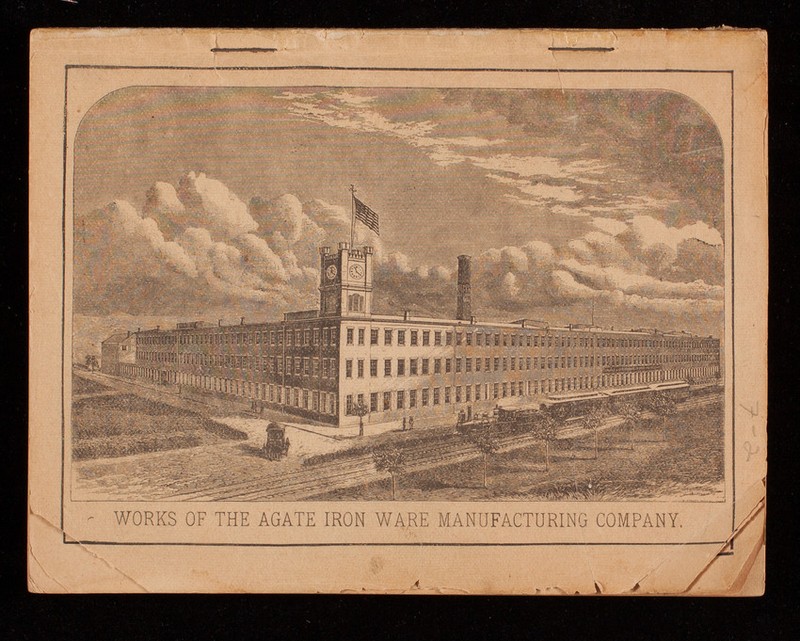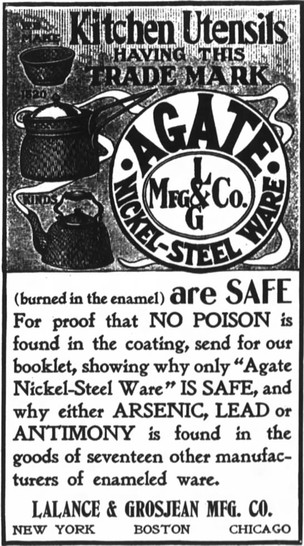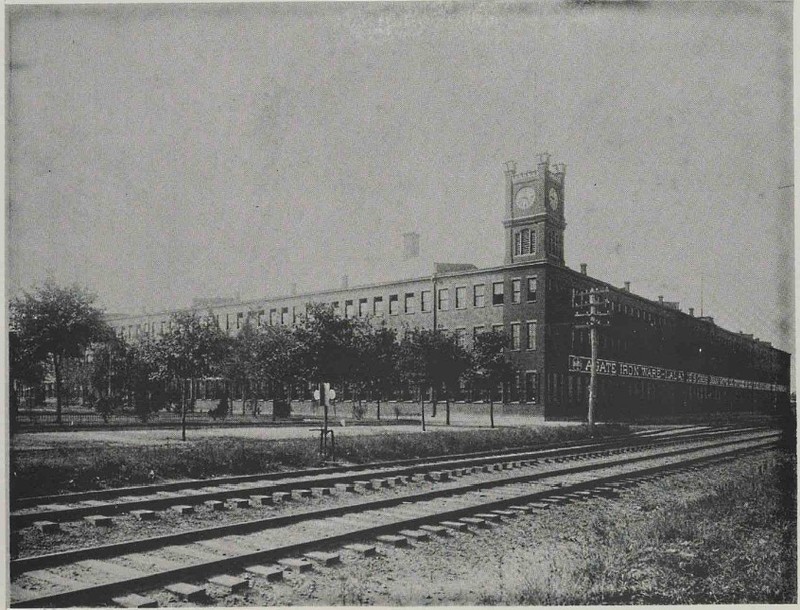Lalance & Grosjean Manufacturing Company Factory (1863-1955)
Introduction
Text-to-speech Audio
Images
A depiction of the Lalance & Grosjean Manufacturing Company's Woodhaven Factory in 1877. A year after the factory fire. Note the Clock Tower, which still stands today.

An advertisement for the Lalance & Grosjean's Manufacturing Company's popular Agate Ware from 1901.

The Woodhaven factory in 1895.

Backstory and Context
Text-to-speech Audio
French immigrant Florian Grosjean entered the kitchen and cutlery business with Charles Lalance in the 1850s. Grosjean mainly operated the company out of its New York City firm and factory located on Pearl Street in lower Manhattan from 1856 to 1863. As the company’s success continued, Lalance returned to France permanently as the firm’s European representative. Grosjean operated as the American director, overseeing the company's growth in New York and beyond.
By 1863, the Lalance & Grosjean Manufacturing Company had outgrown its Pearl Street location. Grosjean looked to Woodhaven, Queens, to expand his tinware operation. A rural locality, Woodhaven’s proximity to Brooklyn, and inexpensive land made the community a prime location for the manufacturing business. In 1863, Grosjean purchased the former site of the John Sharpe factory, conveniently located on Atlantic Avenue, the main thoroughfare for the Long Island Railroad or LIRR. The factory’s location profited from using LIRR to ship manufactured goods and obtain raw materials. The site flourished as demand steadily increased.
Two years after the Woodhaven factory’s initial opening, Grosjean began to build company housing for the business’ employees. Much of the original workers’ housing are now privately owned, located by Atlantic Avenue between 95th and 97th Avenues in Woodhaven. Grosjean, himself purchased property for a private residence located close to the factory. Formerly situated at the present-day intersections of Atlantic Avenue and Woodhaven Boulevard, the Grosjean Estate stood from 1866 to 1912.
In February 1876, a massive fire damaged most of the original factory structure and machinery. Newspapers, such as the Brooklyn Daily Eagle, reported, “It will, for several months at least, stop one of the chief industries in this part of the State, and must leave unemployed several hundred skilled artisans.” Concern for the unemployed grew, and Grosjean decidedly provided his employees with partial pay during the factory’s reconstruction. The factory re-opened in August of 1876, a mere six months after the fire. In addition to new safeguards to prevent another devastating fire, Grosjean installed a Clock Tower on the northeast side of the factory, which still stands today.
Woodhaven developed considerably upon the establishment of the Lalance & Grosjean tinware factory. A report by the Brooklyn Daily Eagle in 1893 states, “When Charles Lalance and Florian Grosjean opened a tinware factory in Woodhaven, the surrounding country was farming land. Today it is the site of one of the finest villages on Long Island, with a population of over six thousand souls.” The company grew continuously prosperous as the business opened another plant in Harrisburg, PA, in 1893. The company operated two other branches in Boston and Chicago in preceding years. In 1898, the company issued mess kits for the United States Army during the Spanish-American War.
By 1900, the company was mass-producing its popular Agate Ware chain, which claimed not to contain poisons such as arsenic and lead in its products’ coating. Florian Grosjean passed away in 1903, remaining active in the company up until his death. During World War II, the factory produced another chain of kitchenware known as Crusader Ware. The Woodhaven factory continued to operate until 1955, when the company decided to shut down the site due to declining sales. The factory’s surrounding buildings ultimately deteriorated over time. In 1984, the remaining structure, including the Clock Tower, was converted into a retail center which continues to be in use today.
Sources
Seyfried, Vincent F. The Story of Woodhaven and Ozone Park. NY. Queens Community Series, 1985.
Copquin, Claudia Gryvatz. The Neighborhoods of Queens. New Haven. Yale University Press, 2007.
History of Queens County, New York: With Illustrations, Portraits, and Sketches of Prominent Families and Individuals. Long Island, NY. W. W. Munsell and Company, 1882.
"The Destruction of the Lalance & Grosjean Mills by Fire." The Brooklyn Daily Eagle (Brooklyn). February 21st, 1876. Page 2.
"Woodhaven's Industry." The Brooklyn Daily Eagle (Brooklyn) . September 17th, 1893. Page 21.
https://www.historicnewengland.org/explore/collections-access/capobject/?refd=EP001.14.028
https://bklyn.newspapers.com/
http://www.projectwoodhaven.com/2010/August/grosjean-cordier.html
